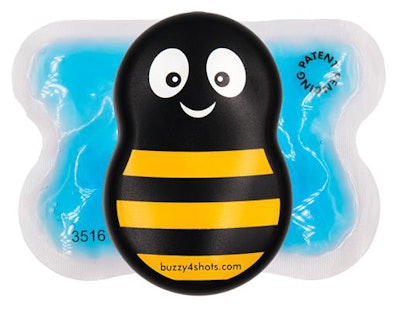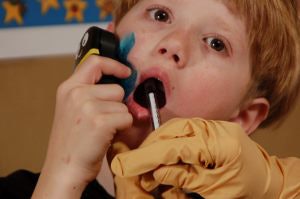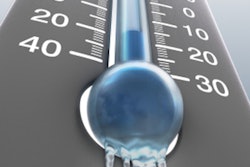
For many children, seeing a long, silver needle headed for their mouth is one of the most fear-inducing parts of dentistry. But a bee-shaped distraction device may help ease this pain and anxiety, according to the findings of a new study.
 Buzzy has a vibrating base and cold wings. All images courtesy of PainCareLabs.
Buzzy has a vibrating base and cold wings. All images courtesy of PainCareLabs.Researchers found children experienced less injection pain when they used Buzzy (PainCareLabs), a device that includes a cold gel compress and vibrating base. They published their findings on December 5 in European Archives of Paediatric Dentistry.
"Recently, the concept of using gels under cold temperatures as an adjunct to a vibrating device has received attention among the dental professionals," wrote the authors, led by Khalid Jamal Alanazi, MSc, from the Riyadh Elm University Department of Pediatric Dentistry in Saudi Arabia. "The rationale of using cold (temperature) coupled with vibration (stimulation) is based on the concept that, as a psychological component, pain is dependent on the patient's attention and perception."
Stimulation to mask pain
Buzzy was created by Amy Baxter, MD, an emergency physician who wanted a reusable device to help control needle pain for her patients. The device contains a bee-shaped, vibrating base with an accompanying ice-cold gel compress shaped like wings. Its goal is to mask injection pain by using multiple stimuli.
"It has been proposed that vibrating or buzzing devices create a distractive environment, causing the brain cells to relay the vibrations, thereby giving room for the delivery of analgesia," the authors wrote. "The addition of the element of cold further confuses the perceptions of signals by the pain pathway, thereby enabling a 'masking effect of pain.' "
While vibrating devices have effectively distracted children getting shots in medical settings, vibration alone has not shown promise for dentistry, according to the authors. Therefore, they wondered whether a device like Buzzy, which uses both cold and vibration, might do a better job of masking pain during a dental injection.
 Buzzy in use during an injection.
Buzzy in use during an injection.To find out, they conducted a study with 60 children between the ages of 6 and 7. All children needed maxillary buccal infiltration analgesia on both sides of their mouth and had no prior dental analgesia experience. The injections of analgesia took place over the course of two dental office visits.
All the children received topical 20% benzocaine gel followed by 1.8 mL of 2% lidocaine with 1:100,000 adrenaline at both visits. Half of the children also used Buzzy during the first visit but not the second, while the other half of the children used Buzzy during the second visit but not the first.
The researchers measured children's pain during the injections in three ways:
- The Wong-Baker Faces Pain Rating Scale: Children pick one of six faces that represents their own pain, which is rated on a scale of 0 to 10, with 0 as no pain and 10 as the worst pain.
- The Face Legs Activity Cry Consolability (FLACC) Scale: The practitioner uses body language clues to estimate children's pain on a scale of 0 to 10, with 0 as no pain and 10 as the worst pain.
- Heart rate with a pulse oximeter
The use of the device appeared to help dull children's pain during the moment of injection. The patients' FLACC scores and heart rate were significantly lower when they used the cold, vibrating device, regardless of whether it was on their first or second visit.

"In this present study, the fact that the patients had a significantly lower heart rate at the time of injection on the test visit than the control visit seems to suggest that external cold and the use of a vibrating device significantly reduced the reaction to the pain of injection in the sample," the authors wrote.
While the Wong-Baker Faces pain scores also were lower with the device, the difference was not significant. This could be accounted for because the perception of pain and the experience of pain are not exactly the same, the researchers noted.
"Children who do not feel pain may still report discomfort while those who experience pain may not report it," the authors wrote. "The fact that all but three of the children reported a better experience with the cold and vibrating device is a significant observation."
Not applicable to all patients
It is important to note the researchers specifically excluded children with very positive or very negative behavior, as well as those with neurobehavioral disorders, to ensure the sample population was representative of the largest contingent of patients at a typical pediatric dental practice. However, as a result, the findings may not be applicable to these types of children. The results may also vary with different injection sites and techniques, the authors noted.
Nevertheless, it appears that a combination of cold and vibration may help to ease children's pain during a dental injection. The researchers hope further studies will validate this link.
"The use of an external cold and a vibrating device significantly reduced the pain and perceived anxiety of children before maxillary infiltration analgesia," the authors wrote. "Further research is needed to validate the efficacy of external cold and vibrating devices for other administration techniques and sites of local dental anesthesia."



















